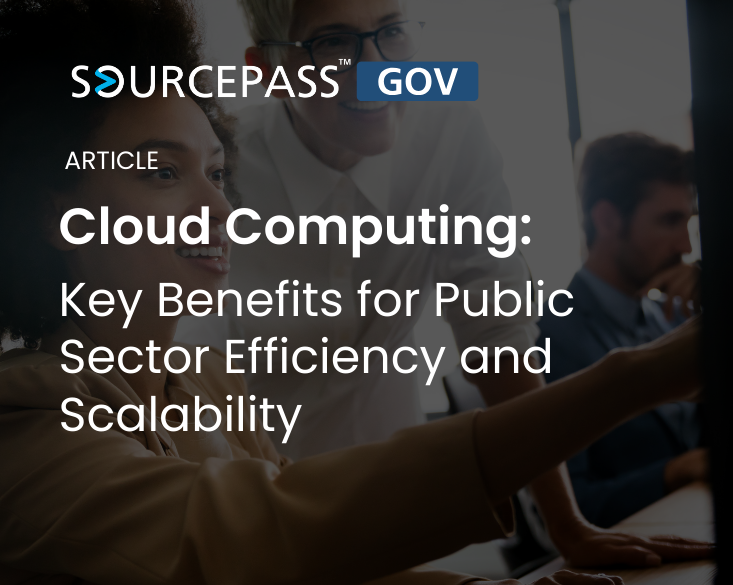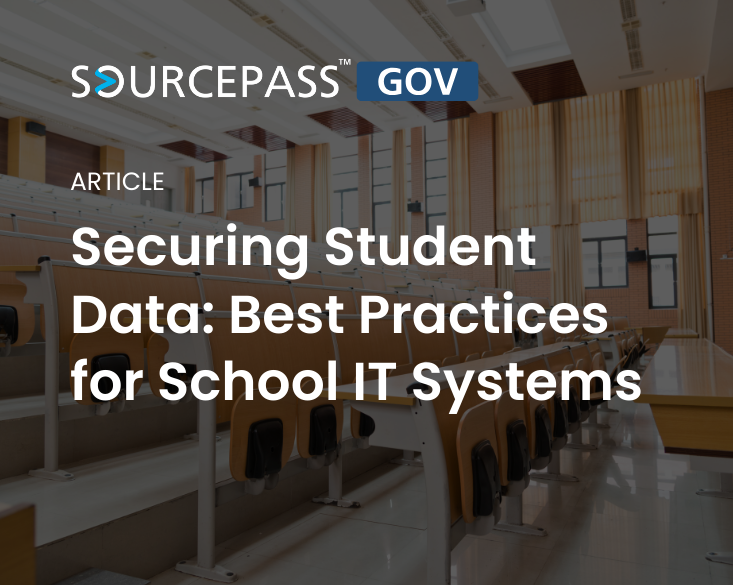3 min read
Top 10 Priorities for State Chief Information Officers
More than halfway through 2025, state Chief Information Officers (CIOs) continue to navigate a dynamic landscape of technological advancements and...
3 min read
Alex Davis : Jan 29, 2025 12:46:18 PM

In today's digital age, cloud computing has become an essential tool for public sector organizations.
As government agencies and those who serve the general public face increasing demand for efficiency, scalability, and cost-effectiveness, cloud solutions are becoming the ideal answer to these challenges.
Cloud computing is the process of delivering computing services to the cloud. This includes servers, storage, software, databases, networking, and analytics. Cloud computing allows public sector organizations to avoid the up front costs and complexities of managing physical IT infrastructure while having the flexibility to scale resources.
For the public sector, cloud computing offers a multitude of benefits, ranging from improved operational efficiency to enhanced scalability. In this blog post, we’ll explore how the public sector can leverage cloud computing to improve service delivery, reduce costs, and enhance overall performance.
One of the most significant advantages of cloud computing is the cost savings. Traditionally, there is a ton of up-front investment to your IT infrastructure, in addition to ongoing costs to manage it.
With cloud computing, costs are dramatically reduced. Organizations can opt to adopt a pay-as-you-go model, paying only for the computing resources they actually use.
This effectively eliminates the need for expensive hardware and reduces those up-front costs as well as the burden of ongoing maintenance. Additionally, cloud providers like Sourcepass GOV take on the responsibility of updating and securing infrastructure, which gives your org more time to focus on your day-to-day duties serving the public.
Cloud computing empowers collaboration between your organization, internal stakeholders, and the public.
With cloud-based applications, employees can share and access data, files, and documents whether they work in-house or remotely. This fosters more efficient collaboration across teams, departments, and teams located in different geographical areas.
Additionally, cloud solutions create a seamless online experience with the public, providing platforms for citizens to access services or request information online, instead of having to come in person.
.png?width=2250&height=1250&name=Sourcepass_Pattern3%20(8).png)
Depending on the organization, IT demands may fluctuate or require specific needs. For instance, demand for IT services can spike at the beginning of a school semester for educational instituations.
Rather than being forced to over-provision their overall infrastructure to accomodate those peaks, cloud computing allows organizations to scale resources up or down as needed, rather than wasting money and resources.
Security should always be a top priority in the public sector, especially when it comes to protecting sensitive data like personal data, financial records, and classified documents.
Cloud service providers, like Sourcepass GOV, understand the stakes involved with keeping data secure and compliant. It's important to invest heavily in best-in-class, robust security measures. This includes encryption, multi-factor authentication (MFA), and advanced monitoring tools. Cloud providers also offer compliance with industry regulations and standards such as GDPR, FISMA, and HIPAA.
Cloud computing also allows for cloud-based data backup and disaster recovery strategies to reduce downtime in the event of a data loss incident. With data stored in the cloud, your organization can more easily recover from cyberattacks, hardware failures, or natural disasters.
Cloud computing also grants access to cutting-edge technology such as AI, machine learning, and big data analytics. When implemented, these features can improve the efficiency and quality of public services. For example, cloud-powered AI tools can help organizations analyze large volumes of data, identify trends, and help make data-driven decisions.
Cloud flexibility also allows your organization to easily and quickly test and deploy new applications and services. In a world where public needs are ever-evolving, cloud computing allows you to develop new solutions quickly. From launching online portals to offering new e-services, you can make public services faster and more efficient.
.png?width=2250&height=1250&name=Sourcepass_Pattern3%20(6).png)
Because the public sector focuses on directly providing essential services to citizens, ensuring business continuity is a major priority. In the event of a disaster, whether it’s a cyberattack, data breach, or natural disaster, your organization must have a way to recovery quickly and reduce business downtime as much as possible.
Cloud computing has built-in business continuity and disaster recovery capabilities through cloud-based backup. Cloud-based backup ensures critical information is securely stored and can be quickly restored in the event of an outage.
By adopting cloud solutions, public agencies can ensure that their services remain operational even in the face of unexpected disruptions, minimizing downtime, recovery costs, and sustaining public trust.
in 2025, many organizations are looking for way to reduce their carbon footprint and contribute to sustainability efforts. Cloud computing can actually help achieve this goal by optimizing energy usage and reducing the need for physical hardware.
A typical IT infrastructure usually features large data centers that are designed for energy efficiency, leveraging advanced cooling technologies and renewable energy sources. By moving to the cloud, on-premise infrastructure is reduced, eliminating physical machinery that consumes significant power and generates waste.
Cloud computing offers local and state government, first responders, and public education sectors an array of benefits that enhance efficiency, scalability, and security.
As the public sector continues to embrace digital transformation, cloud computing will play a central role in shaping the future of government and education. Contact the team of cloud experts at Sourcepass GOV to start your move to the future today!

3 min read
More than halfway through 2025, state Chief Information Officers (CIOs) continue to navigate a dynamic landscape of technological advancements and...

2 min read
Protecting student data is a top priority for school districts. New York's Education Law §2-d, enacted during the 2014-2015 fiscal year, sets forth...

3 min read
Ransomware attacks are a significant threat to state and local governments. These attacks can cripple essential services, compromise sensitive data,...

In 2025, higher education institutions face the dual challenge of providing cutting-edge technology solutions while maintaining robust, secure IT...

In the age of hybrid and virtual learning, schools have become increasingly reliant on technology to enhance learning, improve administrative...
![[Webinar] Modernize Your Infrastructure with Microsoft Modern Workplace](https://blog.sourcepassgov.com/hubfs/Modernize%20Your%20Infrastructure%20with%20Microsoft%20Modern%20Workplace-2.png)
Get an in-depth understanding of Microsoft Modern Workplace in this detailed webinar!